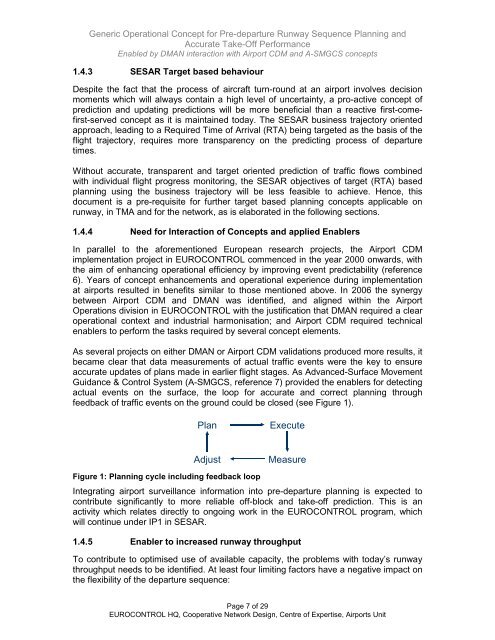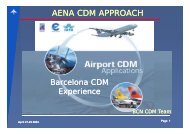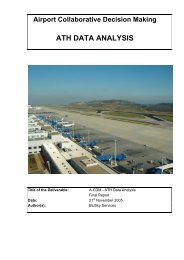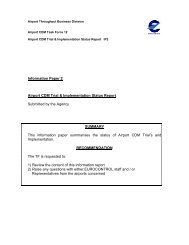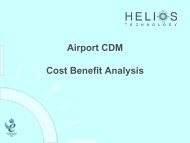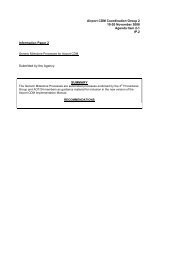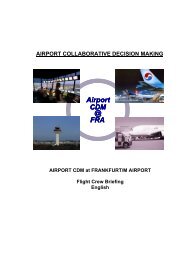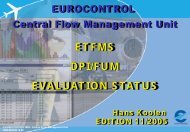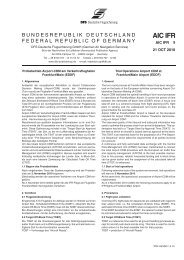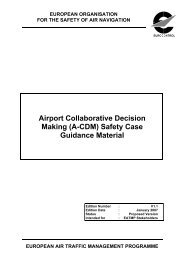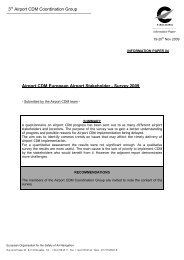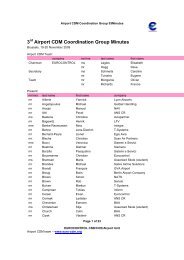Generic Operational Concept for DMAN Interaction v07A - Airport ...
Generic Operational Concept for DMAN Interaction v07A - Airport ...
Generic Operational Concept for DMAN Interaction v07A - Airport ...
Create successful ePaper yourself
Turn your PDF publications into a flip-book with our unique Google optimized e-Paper software.
<strong>Generic</strong> <strong>Operational</strong> <strong>Concept</strong> <strong>for</strong> Pre-departure Runway Sequence Planning and<br />
Accurate Take-Off Per<strong>for</strong>mance<br />
Enabled by <strong>DMAN</strong> interaction with <strong>Airport</strong> CDM and A-SMGCS concepts<br />
1.4.3 SESAR Target based behaviour<br />
Despite the fact that the process of aircraft turn-round at an airport involves decision<br />
moments which will always contain a high level of uncertainty, a pro-active concept of<br />
prediction and updating predictions will be more beneficial than a reactive first-comefirst-served<br />
concept as it is maintained today. The SESAR business trajectory oriented<br />
approach, leading to a Required Time of Arrival (RTA) being targeted as the basis of the<br />
flight trajectory, requires more transparency on the predicting process of departure<br />
times.<br />
Without accurate, transparent and target oriented prediction of traffic flows combined<br />
with individual flight progress monitoring, the SESAR objectives of target (RTA) based<br />
planning using the business trajectory will be less feasible to achieve. Hence, this<br />
document is a pre-requisite <strong>for</strong> further target based planning concepts applicable on<br />
runway, in TMA and <strong>for</strong> the network, as is elaborated in the following sections.<br />
1.4.4 Need <strong>for</strong> <strong>Interaction</strong> of <strong>Concept</strong>s and applied Enablers<br />
In parallel to the a<strong>for</strong>ementioned European research projects, the <strong>Airport</strong> CDM<br />
implementation project in EUROCONTROL commenced in the year 2000 onwards, with<br />
the aim of enhancing operational efficiency by improving event predictability (reference<br />
6). Years of concept enhancements and operational experience during implementation<br />
at airports resulted in benefits similar to those mentioned above. In 2006 the synergy<br />
between <strong>Airport</strong> CDM and <strong>DMAN</strong> was identified, and aligned within the <strong>Airport</strong><br />
Operations division in EUROCONTROL with the justification that <strong>DMAN</strong> required a clear<br />
operational context and industrial harmonisation; and <strong>Airport</strong> CDM required technical<br />
enablers to per<strong>for</strong>m the tasks required by several concept elements.<br />
As several projects on either <strong>DMAN</strong> or <strong>Airport</strong> CDM validations produced more results, it<br />
became clear that data measurements of actual traffic events were the key to ensure<br />
accurate updates of plans made in earlier flight stages. As Advanced-Surface Movement<br />
Guidance & Control System (A-SMGCS, reference 7) provided the enablers <strong>for</strong> detecting<br />
actual events on the surface, the loop <strong>for</strong> accurate and correct planning through<br />
feedback of traffic events on the ground could be closed (see Figure 1).<br />
Plan Execute<br />
Adjust<br />
Figure 1: Planning cycle including feedback loop<br />
Measure<br />
Integrating airport surveillance in<strong>for</strong>mation into pre-departure planning is expected to<br />
contribute significantly to more reliable off-block and take-off prediction. This is an<br />
activity which relates directly to ongoing work in the EUROCONTROL program, which<br />
will continue under IP1 in SESAR.<br />
1.4.5 Enabler to increased runway throughput<br />
To contribute to optimised use of available capacity, the problems with today’s runway<br />
throughput needs to be identified. At least four limiting factors have a negative impact on<br />
the flexibility of the departure sequence:<br />
Page 7 of 29<br />
EUROCONTROL HQ, Cooperative Network Design, Centre of Expertise, <strong>Airport</strong>s Unit


